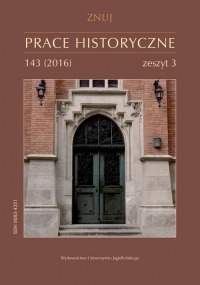Wzorzec dyplomaty przełomu XVI i XVII wieku w świetle staropolskich poradników poselskich
The model of a diplomat at the end of the 16th and beginning of the 17th century in the light of traditional Polish diplomacy guidebooks
Author(s): Urszula Świderska-WłodarczykSubject(s): History, Diplomatic history, Political history, Modern Age, 16th Century, 17th Century
Published by: Wydawnictwo Uniwersytetu Jagiellońskiego
Keywords: wzorzec i jego definicja; dyplomata; poradnik poselski; Krzysztof Warszewicki; Wawrzyniec Piaseczyński; Stanisław Miński
Summary/Abstract: The basic source for the study of the pattern of a diplomat were old diplomacy guides from the end of the 16th and beginning of the 17th century, written by authors such as Krzysztof Warszewicki, Wawrzyniec Piaseczyński and Stanisław Miński. They were all practitioners in the diplomatic service, and each of them had left their own ideas concerning this issue. Despite some differences in the emphasis on individual values, they remained consistent in the basic standards. That convergence concerns not only the axiological aspect, but above all the similarity of approach. As a result, we are dealing with depersonalized though personified patterns. This allows us to distinguish those patterns from personal ones, associated with real characters. This observation prompted the formulation of a new definition of a pattern and personal model, written from a historian’s point of view. Both: the above mentioned differentiation and the distinguishing of values conditioning the existence of patterns and models – hence moral authorities, distinguishing between the objective (external), subjective (internal), professional and socio-religious, constitute the essence of the paper. From this perspective, a model diplomat appears as a noble (usually) wealthy man (prefe-rably), a professional of the highest quality, while at the same time a good husband, son, father, neighbour, statesman, patriot and Christian. Analysing other patterns favoured at the end of the 16th and beginning of the 17th century, it can be seen that in general they represent a sum of clearly positive characteristics. The model of a diplomat ordering a double morality might be an exception to this rule. On the one hand, bearing in mind the tasks that the diplomat had to complete, this double morality was obvious, but on the other hand, such a requirement could evoke, and it really did, ethical discomfort and confusion of values. In no case did those confusions concern the authors of the guides. For them, the sovereignty of the fatherland and the Christian faith always remained the highest values. In the name of such values, even unethical conduct was ethical in every respect, because it served the supreme goals.
Journal: Prace Historyczne
- Issue Year: 143/2016
- Issue No: 3
- Page Range: 537-555
- Page Count: 13
- Language: Polish

